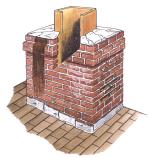

Please click above on this sponsor's banner to see their unique products.
Their sponsorship allows me to continue to provide my web site for you.
Thank you for your support and for visiting my web site.
Search engine visitors - click here to access entire "$ensible Home" web site


Please click above on this sponsor's banner to see their unique products.
Their sponsorship allows me to continue to provide my web site for you.
Thank you for your support and for visiting my web site.
Related links - DIY HVAC/Appliance Maintenance Guides
Dear Jim: I used my fireplace often last winter to lower my heating bills. I know a brick chimney should be cleaned now and then, but what other springtime work is recommended? Can I do the work myself? - Russell H.

A: Spring is the best time to clean and inspect a chimney made of any material. It has been used all winter, so the creosote buildup will be at its maximum now. Also, you should protect the chimney from spring rains which can be damaging to it and the rest of the house if it leaks.
If you used your fireplace regularly during winter, it should be cleaned once a year at the very least to reduce the possibility chimney fires. In 1998 alone, the Consumer Product Safety Commission recorded more than 18,000 chimney fires resulting in 40 deaths and $158 million in losses.
It is possible to do all the chimney maintenance and repairs yourself. Companies, such as SaverSystems, (800) 860-6327, www.saversystems.com, that supply professional chimney sweeps with products, also offer the same ChimneyRx brand products in smaller containers for do-it-yourself home use.
Even though the repairs are easy to do and the maintenance/repair products are now available, it is still wise to have at least one professional cleaning and inspection of your chimney. The chimney sweep will find any problems and you can learn by observing. The Chimney Safety Institute of American, www.csia.org, has a list of its certified chimney sweeps.
The first task is to clean the creosote, the source of most chimney fires, out of the chimney. Running the proper-sized chimney brush up and down from the top of the chimney is the best method. First, seal off the fireplace opening in the room. When working on any roof, even a low or nearly flat one, always wear a safety harness and consider renting a roof ladder.
Moisture is the primary culprit in masonry chimney failures. Brick, concrete and mortar seem hard, but they are permeable to water. Water can damage them over time in any climate, but water is particularly damaging in cold climates with a repeated freeze/thaw cycles.
While you are up on the roof cleaning out the creosote, inspect the cement chimney crown. Chip and brush away any loose pieces. If it is still basically intact and just has some cracks and pits, coat it with a elastomer crown repair material. You can select a brush- or trowel-on material. It stays flexible and seals better than mortar.
A deteriorated or loose flashing can be another spot for water to enter the chimney. Installing new flashing is best, but most homeowners find it much easier to use a flexible flashing repair compound. It is brushed on over the flashing.
Inspect the mortar joints. Remove any loose mortar and fill it with mortar or a concrete-colored elastomer sealant. Finally, seal the entire chimney exterior with a water repellent. Be sure to select one which allows the masonry to breathe so moisture does not get trapped.
There is no Update Bulletin associated with this column.
Dear Jim: I am doing some remodeling at my house. I am interested in the environment and conservation, so I want to use the right type of paint and tools. What do you suggest is the best to use? - Carrie J.
A: The chemicals in paint do give off some unhealthy vapor into the air as it dries. Check at your local paint store for low- or no-VOC (volatile organic chemical) paints.
Black & Decker has a power painting tool, Paintstick, which uses no electricity. The paint is sucked up into the handle. As you push the end of the handle in, it forces the paint into the roller for efficient, even painting.